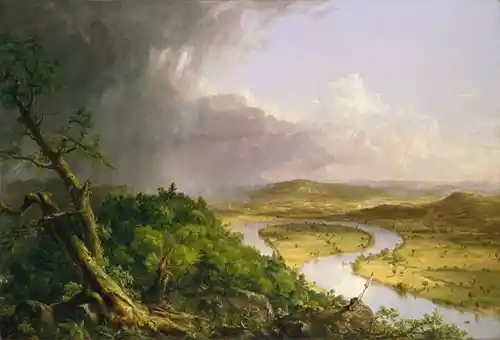Art often draws inspiration from the natural world, capturing the beauty, mystery, and essence of various landscapes. Here are some breathtaking places that have inspired iconic works of art, leaving a lasting legacy in the world of creativity.
Fingal’s Cave, Scotland
Located on the uninhabited island of Staffa in Scotland, Fingal’s Cave is a sea cave known for its unique acoustics and striking basalt columns. The cave’s mesmerizing formation and the echoing sounds of the sea create a mystical atmosphere that has captivated many artists and musicians.
Most famously, this natural wonder inspired the composer Felix Mendelssohn to write his “The Hebrides” overture, now widely known as “Fingal’s Cave”. The artist J.M.W. Turner featured the cave in a dramatic landscape painting in 1832 and it’s been the setting for several poems and plays. Jules Verne referenced it in two of his novels.
Flatford Mill, England
Flatford Mill in Suffolk, England, is immortalized in the paintings of John Constable, one of the greatest landscape artists of the 19th century. Constable’s painting “The Hay Wain” features the mill and its surrounding countryside, capturing the serene beauty of rural England and a vanished rural lifestyle. The fame and enduring beauty of Flatford Mill has made it a beloved subject for other artists and continues to attract visitors who want to experience the landscape that inspired Constable’s masterpieces.
Mont Sainte-Victoire, France
Paul Cézanne painted this mountain in the south of France numerous times, each piece reflecting different perspectives and times of day. Cézanne’s series of paintings featuring Mont Sainte-Victoire are celebrated for their innovative approach to form and color, marking a pivotal moment in the transition from Impressionism to modern art.
Lander’s Peak, USA
Lander’s Peak in Wyoming is renowned for its depiction in the painting “The Rocky Mountains, Lander’s Peak” by Albert Bierstadt. Bierstadt was known for his grand, romanticized landscapes of the American West. This painting, first exhibited in 1863, showcased Bierstadt’s skill in portraying the vastness and splendor of the untamed wilderness.
Bredon Hill, England
Bredon Hill in Worcestershire has been a rich source of inspiration for British poets and composers. A.E. Housman, in his collection “A Shropshire Lad,” evokes the beauty and melancholy of the English countryside, with Bredon Hill featuring prominently in his poetry. The panoramic view across huge swathes of countryside from the hill’s summit also inspired the composers Ivor Gurney and Ralph Vaughan Williams, who set Housman’s words to music. It continues to inspire, thrill and invigorate present-day vistors to Bredon View, Pershore.
Yosemite National Park, USA
Yosemite National Park has inspired countless artists, but perhaps none more famously than Ansel Adams. His black-and-white photographs of Yosemite’s stunning landscapes, including iconic views of Half Dome and El Capitan, have become synonymous with the beauty of the American wilderness. Adams’ work not only captured the majesty of Yosemite but also helped promote the importance of conservation.
The Grand Canal, Venice, Italy
Venice’s Grand Canal has inspired countless works of art, including those by the Venetian painter Canaletto. Known for his detailed and atmospheric cityscapes, Canaletto’s paintings of the Grand Canal capture the essence of Venice’s unique architecture and bustling waterways. His works provide a glimpse into the beauty and charm of 18th-century Venice, making the Grand Canal an enduring symbol of artistic inspiration.
Other painters, including Turner, Paul Signac, John Singer Sargeant and James Whistler, all found inspiration in Venice’s unique landscape. The city’s vibrancy and the chanting of its gondoliers were the muses for composers such as Franz Listz, Antonio Vivaldi, Benjamin Britten and Arthur Sullivan.
These remarkable places and landscapes have not only inspired some of the greatest works of art but continue to draw artists and visitors who seek to experience the beauty and magic that captivated the masters. Whether it’s the rugged beauty of Fingal’s Cave or the serene charm of Flatford Mill, these locations remind us of the profound connection between nature and creativity.




